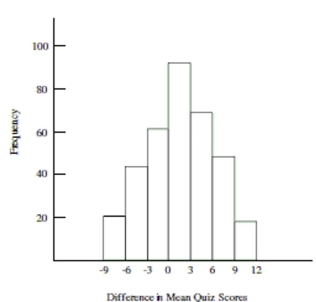Use the following information to answer the question. Math self-efficacy can be defined as one's belief in his or her own
ability to perform mathematical tasks. A college math professor wishes to find out if her students' math self-efficacy matches
reality. To do this she gives a math quiz then asks her students to rate their level of confidence in how well they did on the
quiz. She plans to test whether those who had little confidence that they did well on the quiz actually performed worse than
those who had a high level of confidence that they did well on the quiz. Shown below is the approximate sampling
distribution of the difference in mean quiz scores. The table below shows the summary statistics for the two groups. Assume
that all conditions for a randomization test have been satisfied. 
-Carry out the randomization test. What is the professor's conclusion? Are differences in mean quiz scores due to chance?
A) Reject . The professor should conclude that typical quiz scores for those with high confidence is greater than that of those with low confidence. The student's self-efficacy matches reality.
B) Fail to reject . The professor should conclude that typical quiz scores for those with high confidence is greater than that of those with low confidence. The student's self-efficacy matches reality.
C) Fail to reject . The professor should conclude that there is no difference in mean quiz scores for those with high confidence and those with low confidence. The student's self-efficacy does not match reality.
D) Reject . The professor should conclude that there is no difference in mean quiz scores for those with high confidence and those with low confidence. The student's self-efficacy does not match reality.
Correct Answer:
Verified
Q26: Which of the following is not necessarily
Q28: Which of the following statements could be
Q29: Which of the following statements is not
Q33: Use the histogram to roughly estimate
Q34: You are presented with data from two
Q36: Use the following information to answer
Q39: A new fiber bar is advertised to
Q40: A new fiber bar is advertised to
Q43: Use the following information to answer the
Q44: Calculate the mean, median, and geometric mean
Unlock this Answer For Free Now!
View this answer and more for free by performing one of the following actions

Scan the QR code to install the App and get 2 free unlocks

Unlock quizzes for free by uploading documents